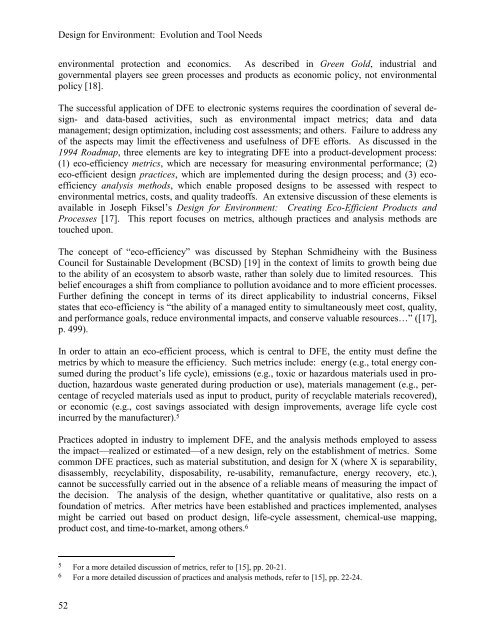1996 Electronics Industry Environmental Roadmap - Civil and ...
1996 Electronics Industry Environmental Roadmap - Civil and ...
1996 Electronics Industry Environmental Roadmap - Civil and ...
Create successful ePaper yourself
Turn your PDF publications into a flip-book with our unique Google optimized e-Paper software.
Design for Environment: Evolution <strong>and</strong> Tool Needs<br />
environmental protection <strong>and</strong> economics. As described in Green Gold, industrial <strong>and</strong><br />
governmental players see green processes <strong>and</strong> products as economic policy, not environmental<br />
policy [18].<br />
The successful application of DFE to electronic systems requires the coordination of several design-<br />
<strong>and</strong> data-based activities, such as environmental impact metrics; data <strong>and</strong> data<br />
management; design optimization, including cost assessments; <strong>and</strong> others. Failure to address any<br />
of the aspects may limit the effectiveness <strong>and</strong> usefulness of DFE efforts. As discussed in the<br />
1994 <strong>Roadmap</strong>, three elements are key to integrating DFE into a product-development process:<br />
(1) eco-efficiency metrics, which are necessary for measuring environmental performance; (2)<br />
eco-efficient design practices, which are implemented during the design process; <strong>and</strong> (3) ecoefficiency<br />
analysis methods, which enable proposed designs to be assessed with respect to<br />
environmental metrics, costs, <strong>and</strong> quality tradeoffs. An extensive discussion of these elements is<br />
available in Joseph Fiksel’s Design for Environment: Creating Eco-Efficient Products <strong>and</strong><br />
Processes [17]. This report focuses on metrics, although practices <strong>and</strong> analysis methods are<br />
touched upon.<br />
The concept of “eco-efficiency” was discussed by Stephan Schmidheiny with the Business<br />
Council for Sustainable Development (BCSD) [19] in the context of limits to growth being due<br />
to the ability of an ecosystem to absorb waste, rather than solely due to limited resources. This<br />
belief encourages a shift from compliance to pollution avoidance <strong>and</strong> to more efficient processes.<br />
Further defining the concept in terms of its direct applicability to industrial concerns, Fiksel<br />
states that eco-efficiency is “the ability of a managed entity to simultaneously meet cost, quality,<br />
<strong>and</strong> performance goals, reduce environmental impacts, <strong>and</strong> conserve valuable resources…” ([17],<br />
p. 499).<br />
In order to attain an eco-efficient process, which is central to DFE, the entity must define the<br />
metrics by which to measure the efficiency. Such metrics include: energy (e.g., total energy consumed<br />
during the product’s life cycle), emissions (e.g., toxic or hazardous materials used in production,<br />
hazardous waste generated during production or use), materials management (e.g., percentage<br />
of recycled materials used as input to product, purity of recyclable materials recovered),<br />
or economic (e.g., cost savings associated with design improvements, average life cycle cost<br />
incurred by the manufacturer). 5<br />
Practices adopted in industry to implement DFE, <strong>and</strong> the analysis methods employed to assess<br />
the impact—realized or estimated—of a new design, rely on the establishment of metrics. Some<br />
common DFE practices, such as material substitution, <strong>and</strong> design for X (where X is separability,<br />
disassembly, recyclability, disposability, re-usability, remanufacture, energy recovery, etc.),<br />
cannot be successfully carried out in the absence of a reliable means of measuring the impact of<br />
the decision. The analysis of the design, whether quantitative or qualitative, also rests on a<br />
foundation of metrics. After metrics have been established <strong>and</strong> practices implemented, analyses<br />
might be carried out based on product design, life-cycle assessment, chemical-use mapping,<br />
product cost, <strong>and</strong> time-to-market, among others. 6<br />
5 For a more detailed discussion of metrics, refer to [15], pp. 20-21.<br />
6 For a more detailed discussion of practices <strong>and</strong> analysis methods, refer to [15], pp. 22-24.<br />
52






